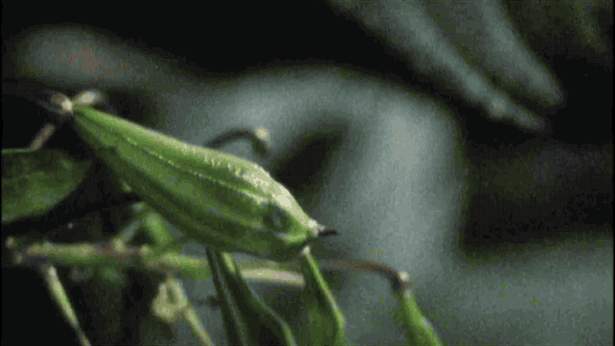Biology concepts – botany, taxonomy, alternation of generations, cycad, gametophyte, sporophyte, gametes, motility, ginkgo, archegonium, antheridium
The male gametes have about a thousand of cilia (not flagella) that pull the cell through the watery environment inside the ovule toward the egg. Fusion and fertilization occurs when the male gametes find the egg – as always. The cycad and ginkgo male gametes swim, but they swim in the indoor pool, not out in the old swimmin’ hole like the bryophytes.
One more cycad exception while we’re here. The cycads can do something that I thought was reserved only for philodendrons and a few relatives. These thermogenic plants can raise the temperature of their male cones by several degrees when the pollen is mature. A 2013 study showed that they can raise the temperature of male cones 2-15 degrees above ambient temperature.
Suinyuy, T., Donaldson, J., & Johnson, S. (2013). Patterns of odour emission, thermogenesis and pollinator activity in cones of an African cycad: what mechanisms apply? Annals of Botany, 112 (5), 891-902 DOI: 10.1093/aob/mct159
Vaughn, K., & Renzaglia, K. (2006). Structural and immunocytochemical characterization of the Ginkgo biloba L. sperm motility apparatus Protoplasma, 227 (2-4), 165-173 DOI: 10.1007/s00709-005-0141-3
Murch, S., Cox, P., & Banack, S. (2004). A mechanism for slow release of biomagnified cyanobacterial neurotoxins and neurodegenerative disease in Guam Proceedings of the National Academy of Sciences, 101 (33), 12228-12231 DOI: 10.1073/pnas.0404926101
Plants are most often called by their binomial system names (genus, species), but this is just naming, not categorizing in a large way. Animals, protists, fungi, etc. are all divided into different phyla based on their similarities ad differences. But for some reason (I hope there’s a reason) botany uses divisions instead of phyla.
There are 10-12 divisions of plants (we’ll use 10), covering everything from the mosses to the flowers. Compare that to 21 phyla of animals and it seems like the plants will be easier to classify – but not so fast.
Group plants according to various characteristics and you start to muddy the waters. You might divide them up according to whether they have vascular tissue or not. Non-vascular plants are short because they don’t have vessels to move water very high – these are the Anthocerotophyta (hornworts), the Bryophyta (mosses), and the Marchantiophyta(liverworts). Together they are called the Bryophytes.
The vascular plants are all seven of the other divisions – the Lycopodiophyta (the spikemosses and clubmosses), Pteridophyta (ferns and horsetails), Coniferophyta (conifers), Cycadophyta (cycads), Ginkgophyta (just one species, Ginkgo biloba), the Gnetophyta (a weird group), and Angiospermae (flowering plants). The conifers, cycads, ginkgo and gnetophytes are often grouped together as the gymnosperms – you’ve probably heard of them.
On the other hand, you might divide the plants up into the seed plants and non-seed plants. In that case, you lump the club mosses and the ferns with the bryophytes, since they all reproduce using spores, not seeds.
Or you could divide them on the basis of how many leaves the embryonic plants have; monocots have one while dicots have two. Angiosperms play by these rules, but gymnosperm seeds don’t, their embryos may have none, one, two, or dozens of cotyledons (embryonic leaves).
Here’s one classification method you may not have heard before – gametophyte dominant vs. sporophyte dominant plants. This has to do with the cycle of life of plants.
Every plant has two lives. Part of its life is spent as a haploid gametophyte (produces haploid gametes) while another plant of the species is a diploid sporophyte. The sporophyte produces spores that grow into the gametophyte, then the gametophyte produces gametes that join together during fertilization to become a new sporophyte.
Some plant types (like bryophytes) exist mostly in the gametophyte stage and are therefore called gametophyte dominant. Other plants (like trees and flowers) spend all there time as sporophytes and only small parts of them become gametophytes (like pollen or cones).
One way you shouldn’t classify plants is based on their movement. Sure, some plants can grow in a certain direction, toward or away from some stimulus (tropisms, see this post), but plants aren’t motile. They don’t pick up and move themselves from one place to another under their own power.
Plants disperse seeds as new plants, but they also disperse their male gametes in order to find the egg on another plant of their species. You have to get the pollen of seed plants (containing male gametes) or the male gametes themselves to the egg. Like seeds, pollen grains can be moved by insect, by wind, by rain, etc. These are the ways most plants get their male gametes to the egg in order to create a new plant, either in a seed or without a seed.
But there are exceptions, and this is weird exception. Some plants have male gametes that are motile. They swim to the egg! No big deal for animals, they pretty much all have motile male gametes (we’ll look at the exceptions to that), but it’s quite the stunner in plants.
Bryophyte males gametes are swimmers. The mosses, liverworts and hornworts live close to the ground and must have standing water for the make gamete to reach the female gametophyte and egg. The haploid gametophytes are the moss that we usually see. The antheridium grow on the top of the male plants to produce male gametes, while the archegonium on the female plant tip produces the ovule with the egg. When the water is high enough the antheridium releases the male gametes and they swim to the egg using two flagella. The sporophyte (diploid) plant grows from the top of the female gametophyte.
Ferns, horsetails, and club mosses are taller than mosses because they are vascular, but they still require water for their male gametes to swim to the egg. The gametpophyte is a heart shaped leaf that lies near the ground. At one spot the archegonium grows the egg, while the male gametes in the antheridium grow nearby. Water resting on the leaf allows the male gametes to swim across the leaf to the egg (or from leaf to leaf). The sporophyte grows from the heart-shaped gametophyte and is the fern we usually think of.
But not allseed plants work this way. A few of the gymnosperms still use a modified version of swimming to the egg.
Cycads (about 300 species) and the lone extant ginkgo, Ginkgo biloba, do have pollen grains that represent the male gametophyte plant. They get blow or carried to the female gametophyte cone and then it gets weird.
The ovule produces a drop of liquid that sticks into the air. The pollen gets caught in this drop and then the drop and the pollen are pulled back into the ovule. The pollen tube grows into the female reproductive organ, but not right to the egg. When the pollen tube reaches the entrance of the archegonium, it ruptures and the gametes are released into a watery fluid that surrounds the eggs.
 |
Cycad and ginkgo male gametes move on their own, the only exceptions in the seed plants. They have hundreds to thousands of cilia, as opposed to flagella in bryophyte gametes, which pull the cell forward. Ginkgo male gametes are huge (0.3 mm), larger than an entire Wolffia globosa plant. |
The male gametes of cycads and ferns are very different, from where they swim, to their relative sizes – ginkgo male gametes are HUGE compared to those of ferns, to the use of thousands of cilia as opposed to a couple of flagella. However, research shows that they are remarkable similar in structure and function.
A 2006 studylooked at the proteins involved in gamete movement in ferns and ginkgo. Their results indicated that most of the proteins in both were homologous enough that it suggested a direct descent from bryophyte to gymnosperm, not a case of parallel evolution.
 |
In Guam, there is a neurologic disease that looks a lot like Alzheimer’s. Research in 2004 found that it was actually coming from cycad trees. Here’s how it happens. Cyanobacteria live in the tree roots and put the toxin BMAA into the tree tissues. Bats eat the fruits and people eat the bats. Than BMAA in the brain causes disease. |
This is believed to attract more insects as pollen distributors, and the researchers did find that more insects visited the plant when the temperature was increased. The mechanism may involve volatilizing more attracting chemicals though the added heat, which would then attract more pollinators (usually weevils). Pretty advanced for a plant with a so-called primitive reproduction mechanism.
Next week – the base of the undulipodia has a special story all its own. Is it another instance of bacteria evolving into one of our organelles? And it has two very different jobs – which came first?
For more information or classroom activities, see:
Alternation of generations –
Seed dispersal –
Pollen –
Cycads –
Ginkgo biloba –




